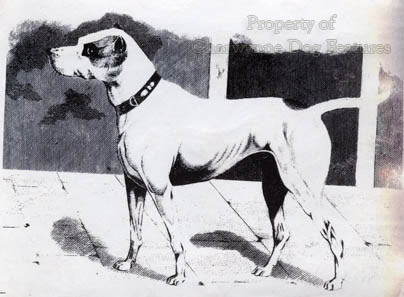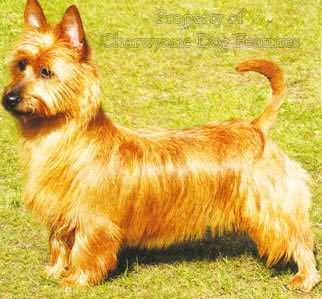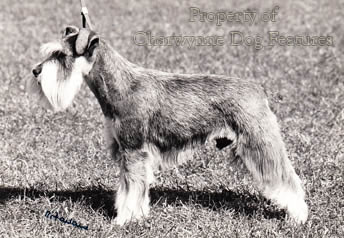679 TERRIERS ABROAD
TERRIERS ABROAD
by David Hancock
 Most of the terrier breeds are quintessentially British. But nowadays we can read of Rat Terriers as a breed in America, the Brazilian Terrier and the well-established Australian Terrier, as well as the misnamed Tibetan Terrier. French and German writers of previous centuries have made reference to dogs functioning as terriers, not just Dachshund types but Pinschers and Schnauzers too. We may have captured the terrier breed market but not the terrier function. The Dutch have re-created their Smoushond, with a distinct terrier appearance. The German Hunt Terrier has fanciers here; the newly-created Cesky Terrier is finding favour here too.
Most of the terrier breeds are quintessentially British. But nowadays we can read of Rat Terriers as a breed in America, the Brazilian Terrier and the well-established Australian Terrier, as well as the misnamed Tibetan Terrier. French and German writers of previous centuries have made reference to dogs functioning as terriers, not just Dachshund types but Pinschers and Schnauzers too. We may have captured the terrier breed market but not the terrier function. The Dutch have re-created their Smoushond, with a distinct terrier appearance. The German Hunt Terrier has fanciers here; the newly-created Cesky Terrier is finding favour here too.
The Dobermann Pinscher and the Giant Schnauzer are, like the Airedale and the Russian Black Terrier, not exactly earth-dogs but the smaller pinschers and schnauzers were farm and stable vermin controllers, just like our native terriers. The smooth-haired Austrian Pinscher has many similarities with our emergent Plummer Terriers. The Franks had a small dog they called the bibarhund or biberhunt, literally beaver-dog. From these came a type referred to as rattlers, both smooth and rough haired. Later came the Rattinpintscher, literally a dog that nips rats, and in time the breed-type we know as the pinscher and schnauzer, literally a dog with a bearded muzzle, developed. The German authority, Richard Strebel, writing in his massive work, Die Deutsche Hunde of 1903, recorded that: "There is little to say about the history of the German Pinscher. Illustrations of the breed are rare. It does not appear in old oil paintings. He occupied such a menial position, so unimportant, that artists felt it not worth their while to depict him for posterity."
That statement echoes the omission of both pastoral dogs and terriers from English paintings of past centuries. In some old English dictionaries, the word pinscher is defined as a dog breed, a short-haired English Terrier, black and tan terrier, rough or wire-haired terrier. Some authorities state that the pinscher originated from stock brought back from England by German workers and that a cross with the French griffon-type produced the rough or wire-haired variety, to become known as the Schnauzer. Interestingly, there is an old English print from the early 1800s depicting a notable bull-and-terrier of that time, with a definite Continental look to it, called "Pinscher".
In Ireland, the unusual smoke-grey coat of the Kerry Blue Terrier has been linked with the Harlequin Pinschers of the soldiers of the House of Hesse, who were stationed there. In Kay's Portraits From Nature (c.1810) there is an illustration from Scotland of a Pinscher; the coastal areas of the Scottish Highlands contained men who served as mercenaries in German armies. The Pinscher may have been imported by them. As far as the German Hunt Terrier is concerned, the reverse may have happened. When I was working in Germany nearly fifty years ago, an old German Forstmeisster told me that his grandfather had imported English hunt terriers to control vermin. International boundaries have never been barriers to the dog trade. 
The past popularity of the Fox Terrier has led to derivatives appearing in more than one country. In America both the Rat Terrier and the Toy Fox Terrier, both recognized breeds, have been developed, as has the Brazilian and Japanese Terriers. In Andalusian Spain the sherry houses and wine shops use another Fox Terrier derivative, the Ratonero Bodeguero, to keep rats under control in their store rooms. In Australia, the Tenterfield Terrier has appeared, with a distinct small Fox Terrier look to it. The Rat Terrier, developed it is said from crosses of Smooth Fox Terrier and the Manchester Terrier, comes in three sizes: 14-23 inches, under 14 but over 10 inches and up to eight inches in the miniature form. The larger sizes were once used in rat-baiting contests, but are famous for achieving huge totals of rats killed on farms, with the record set at around 2,500 rats killed in an infested barn over a seven hour period. They are used by American hunters on squirrel, coon, possum and ground game, as well as in tracking wild boar and deer. Beagle blood has increased size, scenting and hunting skills; Whippet blood has provided the source for the blue and brindle colours. The 10 inch high Toy Fox Terrier is still used as a rat killer, having lost little of its tenacity in its reduced form. 
The Japanese Terrier, 12-13 inches high, is also called the Nippon Terrier, Mikado Terrier and Oyuki or snowy terrier, but is essentially a companion dog. The Brazilian Terrier, also called the Fox Paulistina, is used to control vermin on ranches and estates, is rooted in imported Fox Terrier blood, being around 15-20 lbs weight and in their native country come second to the Filas in numbers of registrations. The Tenterfield Terrier in Australia, around a foot high, can be confused with a Jack Russell, but the head is narrower and finer, and the bone heavier and the build stockier. It is not known outside Australia.
Well known outside Australia however is the national terrier, the Australian by name.
With over 50 registrations each year here, this terrier breed, once dubbed ‘the Australian Rough’, developed in Australia and originating in Tasmania around 1800, where little vermin destroyers weighing around 10lbs and bearing striking blue sheen coats, with tan under markings, became valued. Once known as the broken-coated blue and tan terrier, it is said to have Skye Terrier blood for colour of coat, length of body and shortness of legs, Scottish Terrier blood for harshness of coat and Dandie Dinmont blood for the topknot. There are claims too of Yorkshire terrier blood and the introduction of Irish Terrier blood to stabilise the red colour. It could be that the major input came from the old black and tan rough-coated common terrier of England, taken to Australia by settlers. At 10 inches high and around 14lbs weight, I am impressed by those I see at shows, but I am not aware of their working use by any reputable terrier-men, which is a pity. In his Australian Barkers and Biters of 1914, Robert Kaleski writes these words on the terrier need there: “There is generally in the Australian bush a need for a small vermin-dog – to kill rats, rabbits, foxes, bandicoots, etc…The best dog for this is, of course, a small smooth-haired Terrier; and the best of the smooth-haired Terriers is the ‘Foxie’.” It is worth noting that the blood and performance of our Fox Terrier is rated more in Australia, Japan, Brazil, North America and Southern Spain than here. 
There is a distinct terrier look to the Belgian breed of Schipperke, used as a vermin controller on barges there, they are sharp-witted and quick-moving, with an alert expression and a terrierlike attitude. Coming from the old province of Flanders, they were popular along the canals of Belgium and Holland and have been credited with the first one-breed dog show, one set up by guild workmen in 1690. Strangely our Kennel Club puts this breed in their Utility Group, with the Schauzer and its smaller variety, but puts the German Pinscher in their Working Group and its smaller variety in the Toy Group. The German earth-dog, the Dachshund, is considered by them to be a hound. The German Hunt Terrier is gaining ground here and has a distinct Lakeland Terrier look to it. Welsh and Fox Terrier blood has been claimed in the development of this attractive little sporting dog. As always with German native breeds their breeding is well stewarded and an underground test mandatory for breeding stock.
The Smoushond of Holland has much in common with the old German rough-haired Pinschers but still throws black and tan progeny, with some experts claiming an infusion of English terrier blood in their development. Wherever terrier-like dogs appear in the world an origin in British terrier stock is likely; the reputation of British terriers is rightly acknowledged by dog-breeders all over the developed world.